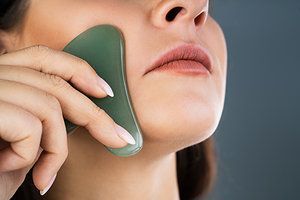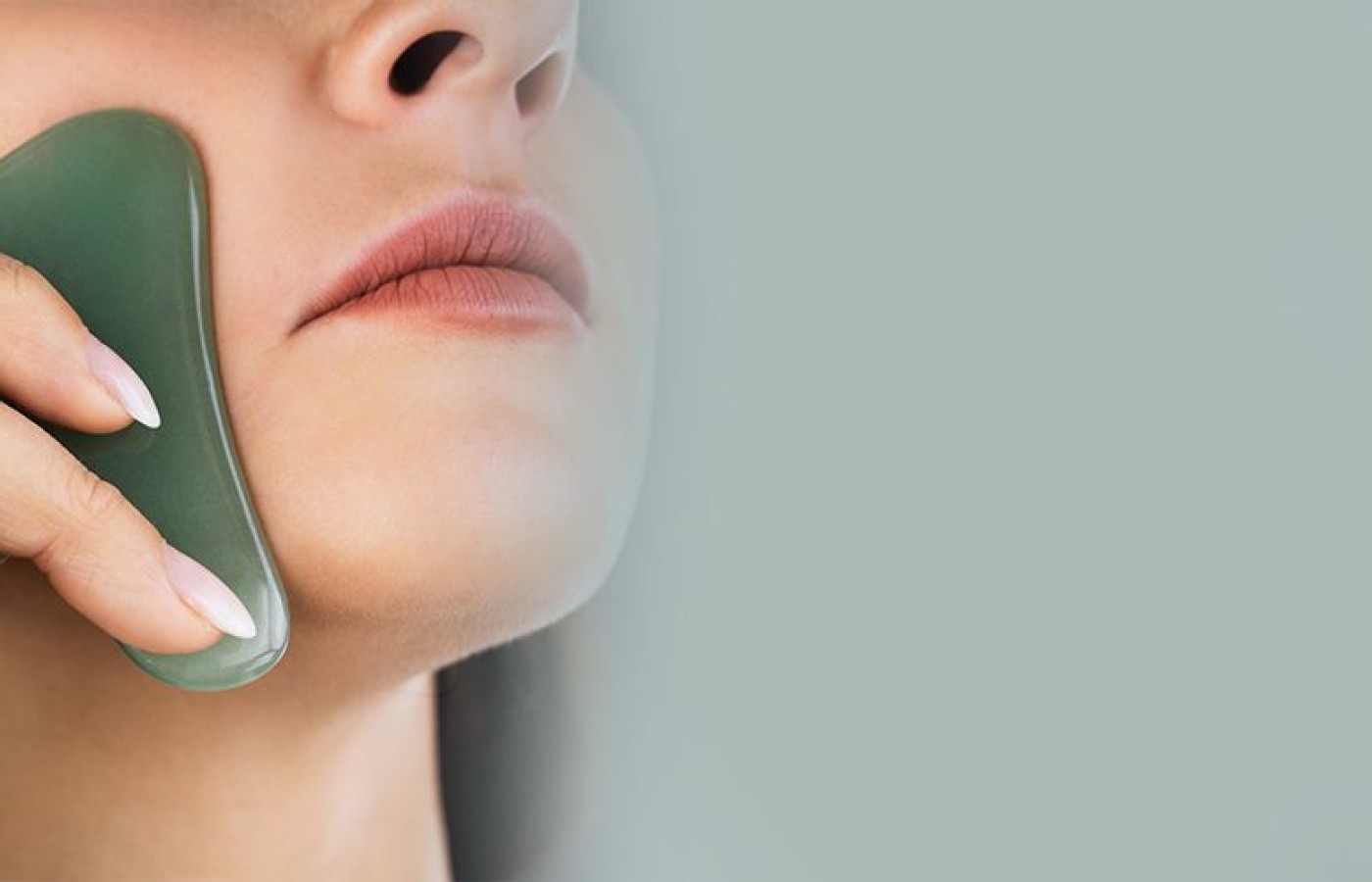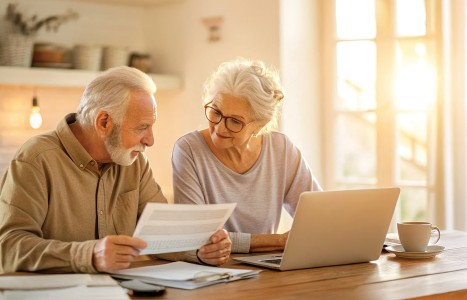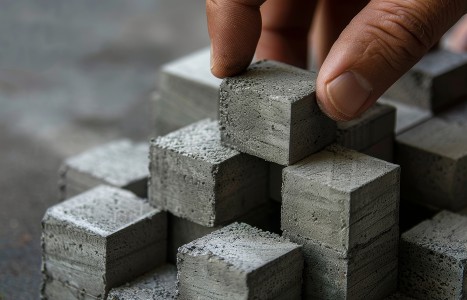Because traditional Chinese medicine (TCM) views the human body as an interconnected network of energy (qi) and seeks to restore balance and harmony, ensuring the smooth flow of qi and blood is crucial to nourish and regulate the reproductive system. TCM treatment aims to regulate menstruation, reduce anovulatory menstruation, help ovulation, improve egg quality, stabilize progesterone, and provide a good endometrium environment for successful implantation and pregnancy.
"Facial Gua Sha" That Isn't Gua Sha at All
Facial treatments have increased in recent decades for both beauty and wellness. A recent trend among some acupuncturists and estheticians (facialists) has been the application of so-called "facial gua sha." However, instrument-assisted stroking of the face, neck or décolleté with jade stone or other gems/minerals in "facial gua sha" does not produce sha petechiae and without sha petechiae and ecchymosis, the biomechanism of gua sha is not produced: it is not gua sha. Therefore, research on the therapeutic effect of gua sha1-2 cannot be claimed for "facial gua sha."
What is Gua Sha?
Gua sha is a healing technique of traditional East Asian medicine. Sometimes called coining, spooning or scraping, gua sha is defined as "instrument-assisted unidirectional press-stroking of a lubricated area of the body surface to intentionally create transitory therapeutic petechiae called 'sha' representing extravasation of blood in the subcutis."2 Modern research shows gua sha produces an anti-inflammatory and immune-protective effect that persists for days following a single treatment.1,3 This can account for its effect on pain, stiffness, fever, chill, cough, wheeze, nausea and vomiting, etc., and why it is effective in acute and chronic internal organ disorders, including liver inflammation in hepatitis.

Gua sha is useful in any licensed therapeutic practice and of particular interest to acupuncturists, massage therapists, physical therapists, physicians, and nurses who work directly with patients, particularly patients with pain. It is used in Asia, in Asian immigrant communities, and by acupuncturists and practitioners of traditional East Asian medicine (TEAM) worldwide. While some practitioners object to estheticians' use of gua sha as not being guided by TEAM principles, in actuality, what they are doing is not gua sha at all.
Rather than gua sha, this treatment is more accurately described as instrument-assisted facial massage; in East Asian medical terms, perhaps instrument-assisted "facial tuina." There are some similarities with Japanese Shonishin.4 If done lightly it may be a kind of instrument-assisted effleurage.
Instrument-Aassisted Massage or Effleurage Soft Touch
Using jade stone to stroke the face is a kind of massage, sometimes called effleurage: soft-touch stroking. Shonishin is a Japanese instrument-assisted light stroking technique used in pediatric medicine.4 These techniques are far lighter than the press-stroking used to raise sha petechiae in gua sha.
Participants report relaxation and other benefits from these facial techniques; however, their therapeutic benefits have not been studied relative to claims made regarding wrinkles or other skin conditions such as acne, rosacea, discoloration or dark circles, sagging or puffy skin, promotion of a short- and long-term radiant complexion, or reversing the effects of aging. Therapeutic benefit is often attributed to an increase in blood circulation, but any increase in circulation from massage abates a few minutes after the massage stops.5
Hence, the benefits of massage that have been established in the treatment of acute pain, cancer pain and chronic pain,6 and that outlast the few minutes of altered circulation, must involve other biomechanisms. So too with facial treatments, whereby a change in circulation or perfusion may play a systemic role in hemodynamics7-8 and alter body chemistry.
Research into the response of fibroblasts to stretching of loose connective tissue, for example, gives insight to downstream cellular and molecular therapeutic effects of connective-tissue mechanotransduction.9 And there are clear benefits experienced by those receiving facial treatments in terms of improved appearance, relaxation and stress reduction. Indeed, the biomechanism of facial treatments, including instrument-assisted massage to the face, is an area of potential research interest.
Gua Sha Research
By contrast, gua sha has an established anti-inflammatory and immune-protective effect that helps to contextualize its historical and modern use to treat pain, fever, heatstroke, acute infectious illness, and acute trauma; as well as chronic conditions that have features of fixed pain, reduced function or loss of range of motion.2
Gua sha increases microperfusion in the immediate term following treatment.3 The sha transitory therapeutic petechiae that represent extravasated blood in the subcutis are absorbed in what is called ferroheme metabolism. This upregulates the genetic expression of heme oxygenase-1 (HO-1) immediately and over the coming days, producing the anti-inflammatory and immune-protective effect.10 For example, single gua sha treatment reduced liver inflammation, providing hepatoprotection in a patient with chronic active hepatitis B,11 consistent with results predicted in animal models.12
Upregulation of HO-1 produces innate anti-viral activity13 with a conceptual cell-protective role in preventing severe complications following COVID-19 infections.14 Gua sha also increases immune response to intradermal vaccination.15 More research into the role of gua sha in viral infection and disease is warranted.
That said, it is the production and resolution of sha petechiae, gua sha's ferroheme metabolism, that is a primary therapeutic mechanism. Instrument-assisted facial stroking does not produce petechiae and ecchymosis, and is, by definition, not gua sha.
Ensuring Safety & Integrity
Estheticians who use gua sha (raising therapeutic sha petechiae) in their work on areas of the body other than the head, face, neck, and décolleté, should confirm that they are licensed to actually touch / treat patients. There are also standards for safe application of gua sha that must be followed if re-using gua sha instruments on multiple people to avoid transfer of blood-borne pathogens.16-17
Estheticians who use facial jade stone in their treatments should not misrepresent it as gua sha, or advertise or communicate unsubstantiated health claims that would, in turn, misrepresent the established therapeutic role of gua sha and undermine the integrity of their own work.
References
- Kwong KK, Kloetzer L, Wong KK, et al. Bioluminescence imaging of heme oxygenase-1 upregulation in the gua sha procedure. J Vis Exp, 2009(30):1385.
- Nielsen A. Gua Sha, A Traditional Technique for Modern Practice, 2nd Edition. Edinburgh: Churchill Livingstone Elsevier, 2013.
- Nielsen A, Knoblauch NT, Dobos GJ, et al. The effect of gua sha treatment on the microcirculation of surface tissue: a pilot study in healthy subjects. Explore, 2007;3(5):456-466.
- Birch S. Shonishin: Japanese Pediatric Acupuncture, 2nd Edition. Stuttgart: ThiemeMedical Publishers, 2016.
- Mars M, Maharaj SS, Tufts M. The effect of compressed air massage on skin blood flow and temperature. Cardiovasc J S Afr, 2005;16(4):215-219.
- 6. Tick H, Nielsen A, Pelletier KR, et al. Evidence-based nonpharmacologic strategies for comprehensive pain care: The Consortium Pain Task Force white paper. Explore, 2018;14(3):177-211.
- Munk N, Symons B, Shang Y, et al. Noninvasively measuring the hemodynamic effects of massage on skeletal muscle: a novel hybrid near-infrared diffuse optical instrument. J Bodyw Mov Ther, 2011;16(1):22-28.
- Monteiro Rodrigues L, Rocha C, Ferreira HT, et al. Lower limb massage in humans increases local perfusion and impacts systemic hemodynamics. J Appl Physiol, 2020;128(5):1217-1226.
- Langevin HM, Bouffard NA, Badger GJ, et al. Dynamic fibroblast cytoskeletal response to subcutaneous tissue stretch ex vivo and in vivo. Am J Physiol Cell Physiol, 2005;288(3):C747-756.
- Kwong KK, Kloetzer L, Wong KK, et al. Bioluminescence imaging of heme oxygenase-1 upregulation in the gua sha procedure. J Vis Exp, 2009(30).
- Chan ST, Yuen JW, Gohel MD, et al. Guasha-induced hepatoprotection in chronic active hepatitis B: a case study. Clin Chim Acta, 2011;412(17-18):1686-1688.
- Zhu Z, Wilson AT, Mathahs MM, et al. Heme oxygenase-1 suppresses hepatitis C virus replication and increases resistance of hepatocytes to oxidant injury. Hepatology, 2008;48(5):1430-1439.
- Xiao S, Zhang A, Zhang C, et al. Heme oxygenase-1 acts as an antiviral factor for porcine reproductive and respiratory syndrome virus infection and over-expression inhibits virus replication in vitro. Antiviral Res, 2014;110:60-69.
- Wagener F, Pickkers P, Peterson SJ, et al. Targeting the heme-heme oxygenase system to prevent severe complications following COVID-19 infections. Antioxidants, 2020;9(6).
- Chen T, Liu N, Liu J, et al. Gua sha, a press-stroke treatment of the skin, boosts the immune response to intradermal vaccination. PeerJ, 2016;4:e2451.
- Nielsen A, Kligler B, Koll BS. Safety protocols for gua sha (press-stroking) and baguan (cupping). Complement Ther Med, 2012;20(5):340-344.
- Nielsen A, Kligler B, Koll BS. Addendum: safety standards for gua sha (press-stroking) and ba guan (cupping). Complement Ther Med, 2014;22(3):446-448.



